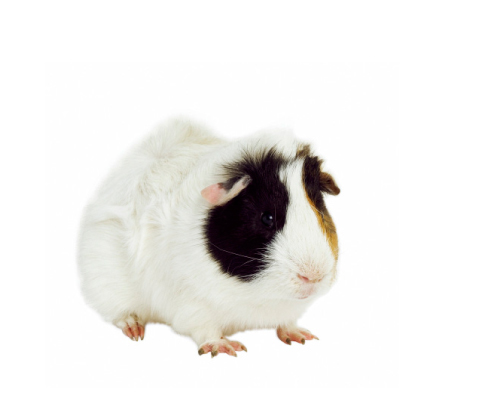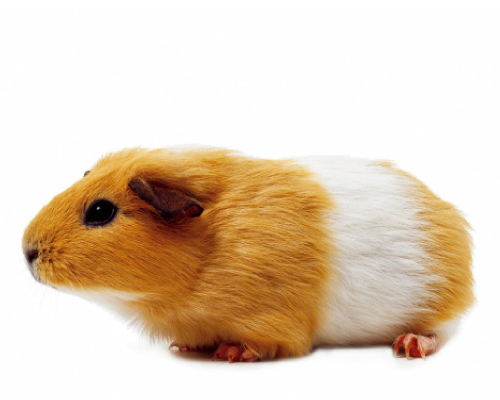
Fact Sheet FS1185
Rabbit ear mites, or Psoroptes cuniculi, are a common parasitic problem responsible for the condition known as ear canker. Considered one of the most common mites of rabbits, it also causes infection in cavies, horses, goats, antelopes, sheep, and cattle. Left untreated, canker can lead to secondary bacterial infections of the skin or invade the middle and inner ear leading to neurological disorders and fatal meningitis.
Type
P. cuniculi is a large, non-burrowing mite, round to oval in shape, which can be seen by eye on an infected animal. Often, however, the mites invade the deeper regions of the external ear canal where they are not visible. The mite is clearly visible when on the external folds of the ear and inside the ear pinnae (ear flap). Mites pierce the skin at the base of hairs and use bell shaped suckers to feed on the host's lymphatic fluids. The mucus and fecal material from the mites cause an inflammatory reaction resulting in severe itching.
Life Cycle
Depending on environmental conditions, the cycle of P. cuniculi is about 21 days. Mites will lay eggs in the ear wax or dead skin of the host. The eggs hatch into larvae in about four days. At this stage, the larvae have six legs and will remain in this stage for four days and then begin to molt. After another three to 10 days, they become eight-legged protonymphs. The protonymphs will then molt into adults, which can mate and lay eggs.
The mites can survive off the host for four to 21 days. The survival rate is greatest when temperatures are low and humidity high (greater than 75%).
Transmission
Rabbit ear canker is extremely contagious and generally spread by direct contact from an infected to non-infected animal. Mites simply crawl from one to another. The mites can also be transmitted through contact with the environment when an animal scratches or shakes, causing flakes of the mite-infested canker containing live mites and eggs to fall. It is thought that a pre-existing moist dermatitis provides a suitable environment for the mites to infest.
Transmission is more likely when large numbers of rabbits, or other susceptible hosts, are housed close to one another such as overcrowded hutches, pet shops, shelters, rabbit breeding facilities, and wild rabbit warrens.
Signs and Symptoms
An initial infestation may be overlooked if it begins deeper in the ear canal. Owners may notice ear scratching and head shaking at this early stage. Other signs include redness, heat, and swelling of the ear canal. As the mites multiply, the infestation expands to the outer ear flap and, at this point, is clearly visible. It is not unusual to have only one ear infested.
The host animal will normally be very agitated at this stage, itching and scratching at its ears and head frequently. The self-trauma of itching and scratching damages the ear skin even more resulting in more inflammation, itching, and scratching. The inflammation also causes serum and white blood cells to ooze onto the skin surface trapping the mites, feces, and skin cells and then drying out. This produces the crusting, scabbing, and thick scale or gray, flaky skin debris attached to the inside of the ear flap. Underneath the crust, the skin is moist, hairless, and raw.
The crusting and scabbing can spread to the head and neck, as well as other parts of the body, through grooming or untreated infestations that multiply. Ear drooping can also be due to the weight of scabbing around the outside of the ear.
If left untreated, ear canker can lead to secondary bacterial infections adding to the pain and discomfort. A foul smell to the ear is an indication of an infection. Head tilt and signs of being off-balance are also indicators of secondary infections and a potential chronic condition.
Treatment
It is important to treat the infected animal and the environment at the same time to prevent re-contamination. While treating the animal, it is recommended to also remove the infected animal from its living environment to give the mites and eggs a chance to die off. A large sized box or crate with clean, disposable bedding makes good temporary housing.
Two main treatment options are available for treating ear mites. Systemic treatments use oral, injectable, or dermal absorbed antiparasitic drugs. Topical treatments apply antiparasitic medications directly to the infected areas as drops, powders, or oils. Systemic treatments are usually preferred because they require fewer repeat dosages, ease of giving, and better results.
P. cuniculi are effectively treated with avermectin drugs, including ivermectin and selamectin. Injections or oral doses of ivermectin repeated over 14 days are more effective than topical applications of the same.
Moxidectin, also an avermectin, has also been shown to be effective against ear canker mites.
Removing the crust and scabs can be extremely painful to the animal and there is debate as to whether or not this should be done. If treated correctly, the medications will allow for easy removal of the crust within a few days or it will begin to fall off on its own within 10 to 14 days of treatment.
Because rabbit ear mites can live for up to three weeks off a host animal, it is important to decontaminate hutches, cages, burrows, feeding sources, and other items in the infested animal's environment.
Physically remove all contaminated and potentially contaminated bedding. It is nearly impossible to chemically decontaminate the large surface area of bedding whether paper, straw, hay, or wood chips. It is best to just remove it all and replace with fresh, clean bedding.
Rest the animal's environment. Leaving the environment free of all rabbits, or other animals, for 4–6 weeks will make sure that it becomes mite free. Treat the hutches, cages, and bedding with an insecticide that is appropriate and safe for the animal. Always read the label carefully before using any insecticide chemical on an animal or its environment. Some insecticides are toxic to rabbits and cavies.
Replace or move housing. Some hutches, especially those made of porous wood, are difficult to clean and remove mites once established. In these cases, it might be easier to replace a hutch or cage. If the animal's housing is close and accessible to wild animal populations, consider moving or modifying to prevent wild mite-carriers from coming into contact with your animals.
References
- Scott, D., Miller, W., and Saunders, W.B. (2001). Dermatoses of pet rodents, rabbits and ferrets. Muller & Kirk's Small Animal Dermatology, (6th ed., pp. 1415-1453). Philadelphia, Pennsylvania: C E. WB Saunders Company.
- Hansen, O., Gall, Y., Pfister, K., and Wieland, B. (2005). Efficacy of a formulation containing imidacloprid and moxidectin against naturally acquired ear mite infestations (psoroptes cuniculi) in rabbits. International Journal of Applied Research in Veterinary Medicine, 3 (4), 281-286.
May 2013
Copyright © 2024 Rutgers, The State University of New Jersey. All rights reserved.
For more information: njaes.rutgers.edu.
Cooperating Agencies: Rutgers, The State University of New Jersey, U.S. Department of Agriculture, and Boards of County Commissioners. Rutgers Cooperative Extension, a unit of the Rutgers New Jersey Agricultural Experiment Station, is an equal opportunity program provider and employer.



